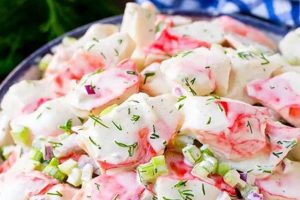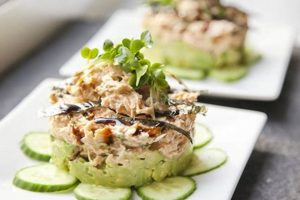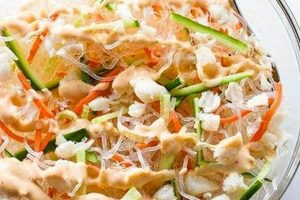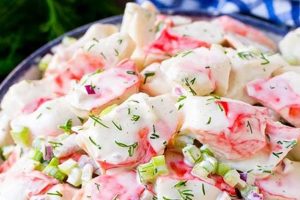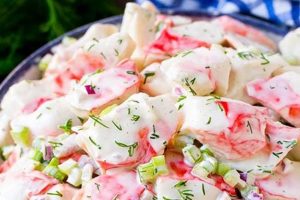A dish featuring a chilled mixture of cooked imitation crab meat combined with other ingredients like mayonnaise, celery, onion, and seasonings constitutes a common variation of seafood salad. This type of salad often includes additional elements such as hard-boiled eggs, relish, or lemon juice, offering a cost-effective alternative to salads made with real crab.
Such salads provide a convenient and affordable way to enjoy the flavor profile reminiscent of crab. The use of imitation crab, typically made from surimi (processed white fish), makes these salads accessible to a wider range of budgets. Furthermore, the extended shelf life of imitation crab contributes to the practicality of this dish, allowing for meal preparation in advance. Historically, the increasing popularity of surimi-based products correlates with a rising demand for accessible seafood alternatives.
This exploration of imitation crab-based seafood salad will delve into variations, nutritional information, preparation techniques, and tips for selecting high-quality ingredients.
Tips for Imitation Crab Seafood Salad
Optimizing the flavor and texture of imitation crab seafood salad requires attention to ingredient selection and preparation techniques.
Tip 1: Thaw and Drain Thoroughly: Excess moisture can dilute the salad’s flavor. Ensure the imitation crab is fully thawed and patted dry before incorporating it into the mixture.
Tip 2: Enhance Flavor with Seasonings: Old Bay seasoning, dill, paprika, and lemon pepper complement the subtle flavor of imitation crab. Experiment with different combinations to achieve desired taste profiles.
Tip 3: Balance Creamy and Crunchy Textures: Finely diced celery, red onion, and bell peppers add a desirable crunch. Balance these with the creaminess of mayonnaise or a lighter alternative like Greek yogurt.
Tip 4: Elevate with Fresh Herbs: Fresh dill, parsley, or chives contribute brightness and complexity. Add these herbs just before serving to maximize their impact.
Tip 5: Choose High-Quality Mayonnaise: The quality of mayonnaise significantly impacts the overall flavor. Opt for a brand known for its rich flavor and smooth texture.
Tip 6: Chill Before Serving: Chilling allows the flavors to meld and enhances the salad’s refreshing quality. Refrigerate for at least 30 minutes before serving.
Tip 7: Consider Accompaniments: Serve the salad on crackers, lettuce cups, or as a sandwich filling. These accompaniments add textural variety and enhance the dining experience.
Attention to these details elevates a simple imitation crab salad into a flavorful and satisfying dish.
By following these guidelines, one can create a delicious and budget-friendly seafood salad suitable for various occasions.
1. Imitation Crab Quality
Imitation crab quality directly impacts the overall success of a seafood salad recipe using this ingredient. Higher-quality imitation crab typically exhibits a firmer texture and a more delicate, nuanced flavor profile, closer to that of real crab. This translates to a more satisfying sensory experience within the salad, avoiding the mushy texture or overly fishy taste sometimes associated with lower-quality options. For instance, a salad made with premium imitation crab featuring real Alaskan Pollock will likely offer a superior taste and texture compared to one made with a product primarily composed of less desirable white fish species and excessive fillers. The choice of imitation crab influences not only the immediate taste but also how well the ingredient holds up within the salad, preventing it from becoming overly watery or disintegrating during mixing and chilling.
The impact of imitation crab quality extends beyond flavor and texture. Higher-grade products often contain fewer additives and fillers, aligning with consumer preferences for cleaner ingredient lists. This can also contribute to a better nutritional profile, potentially reducing the overall sodium content or incorporating beneficial omega-3 fatty acids derived from the fish used in the surimi. Furthermore, superior imitation crab tends to absorb flavors from the other salad components more effectively, creating a more cohesive and balanced final product. For example, a high-quality imitation crab will readily take on the flavors of a dill and lemon dressing, whereas a lower-quality product might be overwhelmed by the seasoning or retain a distinct, less desirable aftertaste.
Selecting high-quality imitation crab represents a crucial step in preparing a truly delicious and enjoyable seafood salad. The investment in a superior product ultimately enhances the overall culinary experience. While cost considerations are understandable, the difference in quality often justifies the slight price increase. Recognizing the connection between ingredient quality and final product satisfaction empowers consumers to make informed choices, leading to a more rewarding dining experience.
2. Mayonnaise Selection
Mayonnaise acts as a crucial binding agent and flavor component in seafood salad featuring imitation crab. Its quality and characteristics significantly influence the overall texture, taste, and enjoyment of the dish. Careful consideration of mayonnaise selection ensures a cohesive and balanced final product.
- Flavor Profile
Mayonnaise varieties range from tangy to sweet, with varying levels of richness and complexity. A classic, neutral-flavored mayonnaise allows the delicate flavor of the imitation crab and other ingredients to shine. However, some recipes may benefit from a mayonnaise with a bolder flavor profile, such as one infused with lemon or dill, to complement the seafood elements. For example, a zesty lemon mayonnaise can brighten the overall taste, while a dill-infused mayonnaise can enhance the oceanic notes of the salad.
- Texture and Consistency
Mayonnaise consistency impacts the salad’s final texture. A thick, creamy mayonnaise creates a luxurious mouthfeel, while a thinner mayonnaise results in a lighter, more delicate salad. The choice depends on personal preference and the desired outcome. For example, a thicker mayonnaise may be preferred for a heartier salad served on bread, while a thinner mayonnaise may be more suitable for a lighter salad served in lettuce cups.
- Ingredient Quality
The quality of ingredients within the mayonnaise itself affects the overall flavor and healthfulness of the salad. Mayonnaise made with high-quality oils, such as extra virgin olive oil or avocado oil, contributes a richer flavor and potentially healthier fats. Conversely, mayonnaise made with lower-quality oils may impart a less desirable taste and potentially contain unhealthy trans fats. Examining ingredient lists aids in informed selection.
- Quantity and Balance
The amount of mayonnaise used dictates the salad’s richness and moisture content. Too little mayonnaise can result in a dry, crumbly salad, while too much can make it overly rich and heavy. Careful balancing of mayonnaise with other ingredients, such as celery, onion, and herbs, ensures a harmonious blend of flavors and textures. For example, a salad with a higher proportion of vegetables might require more mayonnaise to achieve the desired creaminess.
Considering these facets of mayonnaise selection elevates imitation crab seafood salad from a simple dish to a carefully crafted culinary creation. The interplay of mayonnaise flavor, texture, quality, and quantity ultimately determines the overall sensory experience. A well-chosen mayonnaise harmonizes with the other ingredients, creating a balanced and satisfying seafood salad.
3. Fresh Vegetable Additions
Fresh vegetable additions play a vital role in seafood salad recipes featuring imitation crab, contributing significantly to texture, flavor, and overall nutritional value. These additions provide crucial contrasts to the richness of the mayonnaise and the subtle flavor of the imitation crab, creating a more balanced and enjoyable culinary experience. Understanding the strategic incorporation of fresh vegetables elevates this dish beyond simple convenience food.
- Textural Contrast
Fresh vegetables introduce diverse textures, counterbalancing the softer textures of imitation crab and mayonnaise. Crisp vegetables like celery, red onion, and bell peppers offer a satisfying crunch, while finely diced carrots or cucumbers provide a subtle textural variation. This interplay of textures prevents the salad from becoming monotonous and adds to the overall sensory appeal. For instance, the snap of diced celery against the creamy mayonnaise and flaky imitation crab creates a dynamic mouthfeel.
- Flavor Enhancement
Beyond textural contributions, fresh vegetables introduce nuanced flavors that complement and enhance the overall taste profile. The slightly bitter bite of red onion, the peppery notes of finely diced bell pepper, or the fresh, herbaceous flavor of chopped dill or parsley add depth and complexity. These flavors interact with the subtler taste of the imitation crab, creating a more well-rounded and satisfying flavor profile.
- Nutritional Enrichment
Fresh vegetables contribute essential vitamins, minerals, and dietary fiber, boosting the nutritional value of the salad. While imitation crab provides a source of protein, its nutritional profile benefits from the addition of nutrient-rich vegetables. Incorporating a variety of colorful vegetables, such as red bell peppers (rich in Vitamin C) or carrots (rich in Vitamin A), further enhances the nutritional content and adds visual appeal.
- Visual Appeal
The vibrant colors of fresh vegetables enhance the visual presentation of the seafood salad, making it more appetizing. The bright green of celery, the deep red of diced tomatoes, or the vibrant orange of carrots create a visually appealing contrast against the pale backdrop of the imitation crab and mayonnaise. This visual element plays a significant role in the overall enjoyment of the dish.
The strategic inclusion of fresh vegetables transforms imitation crab seafood salad from a basic dish into a more complex and satisfying culinary experience. The interplay of textures, flavors, nutritional enhancements, and visual appeal elevates the dish, showcasing how thoughtful ingredient selection contributes to a more enjoyable meal. The careful balance of these elements ensures a delicious and visually appealing salad that satisfies both palate and nutritional needs.
4. Seasoning Balance
Seasoning balance represents a critical factor in seafood salad recipes featuring imitation crab. The inherent subtlety of imitation crab’s flavor necessitates careful consideration of seasonings to create a harmonious and palatable dish. A balanced seasoning profile enhances the overall sensory experience, preventing the salad from tasting bland or, conversely, overwhelmed by a single dominant flavor. The following facets illustrate the complexities of seasoning balance within this specific culinary context.
- Enhancing Natural Flavors
Seasonings should enhance, not mask, the delicate flavor of imitation crab. Subtle additions of Old Bay, dill, or lemon pepper complement the existing flavor profile without overpowering it. For example, a touch of Old Bay seasoning can evoke the subtle sweetness and oceanic notes of crab, while excessive amounts might create an overly salty and spicy flavor that overshadows the other ingredients.
- Balancing Salt and Acidity
Careful balancing of salt and acidity contributes significantly to a well-rounded flavor profile. A pinch of salt enhances the other flavors, while a squeeze of lemon juice or a splash of vinegar provides brightness and cuts through the richness of the mayonnaise. A proper balance prevents the salad from tasting overly salty or excessively acidic. For instance, balancing the saltiness of capers with the acidity of lemon juice creates a harmonious interplay of flavors.
- Considering Complementary Spices
Complementary spices, such as paprika, smoked paprika, or a pinch of cayenne pepper, can add depth and complexity. These additions should be used judiciously to avoid overpowering the delicate flavor of the imitation crab. A small amount of smoked paprika, for example, can introduce a subtle smoky depth, while excessive use can create an overpowering and unbalanced flavor profile.
- Fresh Herbs for Brightness
Fresh herbs like dill, parsley, chives, or tarragon introduce a vibrant freshness and complexity. These additions should be incorporated just before serving to maintain their vibrancy and prevent them from becoming wilted or losing their aromatic qualities. Fresh dill, for example, provides a bright, herbaceous note that complements the seafood flavors, while wilted dill can impart a less desirable, slightly bitter taste.
Achieving seasoning balance in an imitation crab seafood salad involves a nuanced understanding of flavor interactions and careful ingredient selection. Each seasoning plays a specific role in enhancing the overall taste experience, contributing to a well-rounded and satisfying dish. The interplay of these seasonings creates a harmonious blend that elevates the simple combination of imitation crab and mayonnaise into a more complex and enjoyable culinary creation.
5. Texture Optimization
Texture optimization plays a crucial role in the overall enjoyment of seafood salad featuring imitation crab. This optimization involves a careful balance of contrasting textures to create a more dynamic and satisfying sensory experience. The inherent texture of imitation crab, often described as slightly flaky and tender, serves as a foundation upon which other textural elements build, adding depth and complexity to the dish. Without textural variation, the salad risks becoming monotonous and less appealing. For example, a salad consisting solely of imitation crab and mayonnaise might feel overly smooth and lack textural interest.
Several strategies contribute to successful texture optimization. The incorporation of crunchy vegetables, such as finely diced celery, red onion, or bell peppers, provides a stark contrast to the softer textures of the imitation crab and mayonnaise. This interplay of soft and crisp elements creates a more engaging mouthfeel. Furthermore, the size and shape of the ingredients influence the perceived texture. Finely dicing vegetables creates a delicate crunch, while larger pieces offer a more substantial bite. Consider a salad with coarsely chopped celery versus one with finely minced celery; the former offers a more pronounced crunch, while the latter provides a gentler textural variation. The addition of chopped nuts, such as toasted almonds or walnuts, introduces another layer of textural complexity, adding a pleasant nuttiness and a satisfying crunch.
Textural optimization extends beyond the inclusion of contrasting elements. The inherent moisture content of ingredients also influences the final texture. Properly draining imitation crab prevents excess moisture from diluting the salad and creating a watery consistency. Similarly, the type of mayonnaise used impacts the overall texture. A thicker mayonnaise contributes to a creamier, more substantial salad, while a thinner mayonnaise results in a lighter, more delicate texture. Understanding these nuances allows for precise control over the final product, ensuring a balanced and enjoyable textural experience. A well-optimized seafood salad offers a symphony of textures, enhancing the overall enjoyment and creating a more memorable culinary experience.
6. Chilling Duration
Chilling duration significantly impacts the quality and flavor profile of seafood salad incorporating imitation crab. This chilling period performs several crucial functions. First, it allows the flavors of the various ingredientsthe imitation crab, mayonnaise, vegetables, and seasoningsto meld and harmonize. A freshly prepared salad often presents individual ingredient flavors as distinct rather than integrated. Chilling allows these flavors to blend, creating a more cohesive and balanced taste. For example, the subtle sweetness of imitation crab becomes more pronounced when balanced by the acidity of lemon juice and the savory notes of dill after a period of chilling.
Furthermore, chilling enhances the textural qualities of the salad. The cool temperature firms the imitation crab, preventing it from becoming mushy, and solidifies the mayonnaise, creating a more desirable consistency. This is particularly important for salads that include diced vegetables, as chilling helps maintain their crispness and prevents them from becoming soggy. Imagine a seafood salad prepared several hours in advance versus one consumed immediately; the chilled salad maintains its structural integrity, offering a more pleasing textural experience.
Finally, from a food safety perspective, chilling is crucial. Cold temperatures inhibit bacterial growth, ensuring the salad remains safe for consumption. Maintaining the salad at a refrigerator temperature of 40F (4C) or below minimizes the risk of foodborne illnesses. This is especially critical for salads containing mayonnaise, a perishable ingredient that can spoil quickly at room temperature. Therefore, sufficient chilling duration not only enhances flavor and texture but also safeguards against potential health risks. Proper chilling is integral to a safe and enjoyable seafood salad experience. Neglecting this step compromises both the culinary and safety aspects of the dish.
7. Serving Suggestions
Serving suggestions for seafood salad featuring imitation crab significantly enhance the dining experience, transforming a simple dish into a more versatile and appealing culinary creation. Consideration of presentation and accompaniments elevates both the visual appeal and the overall enjoyment of the salad. Appropriate serving suggestions also contribute to the perceived value and satisfaction derived from this budget-friendly dish.
- Classic Bread Pairings
Serving the salad on bread provides a familiar and convenient option. Options range from classic white bread or whole wheat bread to croissants or rolls. Toasting the bread adds textural contrast and prevents the salad from making the bread soggy. For example, a croissant filled with imitation crab salad provides a flaky, buttery counterpoint to the creamy salad. The choice of bread influences the overall flavor profile and perceived richness of the dish.
- Fresh Green Accompaniments
Utilizing fresh greens adds a refreshing element and elevates the presentation. Lettuce cups, such as butter lettuce or romaine hearts, offer a crisp, cool vessel for the salad. Alternatively, a bed of mixed greens, such as spinach or arugula, provides a peppery counterpoint and adds visual interest. These options contribute a textural and flavor dimension, contrasting the creamy salad with fresh, leafy greens. Serving the salad atop a bed of greens also enhances the perceived freshness and lightness of the dish.
- Crackers and Dippers
Crackers or other dippers provide a crunchy and convenient serving method. Plain crackers, such as saltines or Ritz crackers, offer a neutral base that allows the flavors of the salad to shine. Alternatively, seeded crackers or flavored crisps introduce additional textural and flavor elements. For example, serving the salad with multigrain crackers adds a nutty and earthy dimension. The choice of cracker influences the overall flavor profile and textural experience.
- Creative Presentations
Beyond traditional serving suggestions, creative presentations can elevate the dining experience. Hollowed-out tomatoes or avocado halves provide visually appealing and flavorful vessels. Alternatively, using small pastry shells or cucumber rounds creates elegant appetizers. Such presentations enhance the perceived value and sophistication of the dish, making it suitable for more formal occasions or gatherings. For example, serving imitation crab salad in avocado halves provides a creamy, visually appealing presentation with complementary flavors.
Thoughtful consideration of serving suggestions elevates imitation crab seafood salad from a simple meal to a more considered culinary experience. These choices impact not only the presentation but also the overall flavor profile, texture, and perceived value of the dish. Selecting appropriate accompaniments complements the salad’s existing flavors and textures, creating a more satisfying and enjoyable meal. The versatility of this dish allows for adaptation to various occasions and preferences, demonstrating that even budget-friendly options can offer a sophisticated and satisfying dining experience.
Frequently Asked Questions
This section addresses common inquiries regarding seafood salad prepared with imitation crab, offering clarity and practical guidance.
Question 1: What is imitation crab?
Imitation crab, also known as surimi, is a processed seafood product typically made from white fish, such as pollock or cod. It is flavored and textured to resemble crab meat, offering a more affordable alternative.
Question 2: Is imitation crab healthy?
Imitation crab offers a source of protein but can be high in sodium and contain additives. Nutritional content varies based on the specific brand and ingredients. Moderation and careful product selection are advised.
Question 3: How long can imitation crab seafood salad be stored?
Properly stored in an airtight container in the refrigerator, imitation crab seafood salad typically lasts for three to five days. Spoilage signs include a sour odor or discoloration.
Question 4: Can imitation crab seafood salad be frozen?
Freezing is not recommended, as it negatively affects the texture of both the imitation crab and the mayonnaise, resulting in a watery consistency upon thawing.
Question 5: What are suitable alternatives to mayonnaise in imitation crab seafood salad?
Greek yogurt or plain yogurt offer healthier alternatives to mayonnaise, providing a lighter texture and lower fat content. Avocado can also be used for a creamy, vegan alternative.
Question 6: How can the flavor of imitation crab seafood salad be enhanced?
Fresh herbs, such as dill or parsley, spices like Old Bay or paprika, and a squeeze of lemon juice can significantly enhance the flavor profile. Experimentation with different combinations allows for personalized taste preferences.
Understanding these key aspects of imitation crab seafood salad allows for informed choices regarding preparation, storage, and consumption. Careful consideration of ingredients and preparation methods ensures a satisfying and safe culinary experience.
For further exploration, consider consulting reputable culinary resources or exploring variations on this versatile dish.
Seafood Salad Recipe Imitation Crab
Exploration of seafood salad recipes utilizing imitation crab reveals a dish offering affordability, convenience, and adaptability. Careful selection of imitation crab, combined with thoughtful incorporation of fresh vegetables, seasonings, and mayonnaise, yields a balanced and flavorful salad. Textural optimization, achieved through varied ingredient sizes and types, contributes significantly to enjoyment. Proper chilling enhances both flavor and food safety. Versatile serving suggestions, ranging from classic bread pairings to creative presentations, further elevate the dining experience.
Ingredient quality remains paramount in maximizing enjoyment and nutritional value. Continued exploration of variations and flavor profiles promises to further enhance the culinary potential of this adaptable dish. Emphasis on freshness, balanced flavors, and thoughtful presentation elevates imitation crab seafood salad beyond a simple convenience food, transforming it into a satisfying and versatile culinary option.

